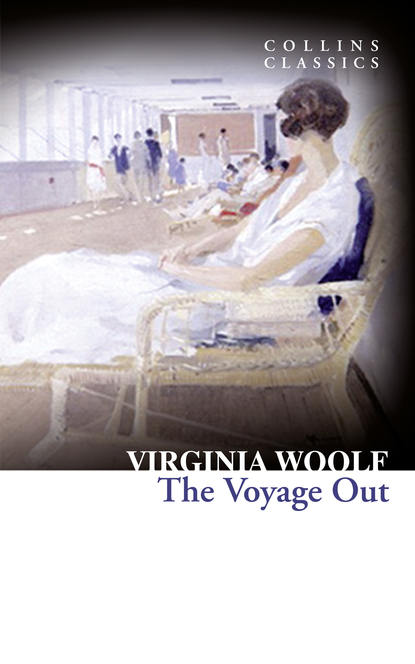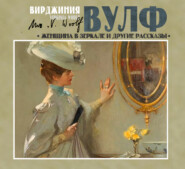По всем вопросам обращайтесь на: info@litportal.ru
(©) 2003-2025.
✖
The Voyage Out
Автор
Год написания книги
2019
Настройки чтения
Размер шрифта
Высота строк
Поля
The Voyage Out
Virginia Woolf
HarperCollins is proud to present its incredible range of best-loved, essential classics.The young Rachel Vinrance leaves England on her father’s ship, the Euphrosyne, on a voyage to South America. Despite being accompanied by her father and her aunt and uncle, Helen and Ridley Ambrose, the passage leads to Rachel’s awakening, both as a woman and as an individual. As the ship is wracked by storms, she finds herself romantically entangled with Richard Dalloway, an encounter that leaves her troubled and confused.Upon arrival in Santa Marina, Rachel strikes off alone to contemplate her identity, and finds finds herself with the aspiring novelist Terence Hewet. As the emerging romance between the two is complicated by their disagreements about gender and art, another storm, and tragedy, appear on the horizon.
THE VOYAGE OUT
Virginia Woolf
History of Collins (#ubd6defc5-a92e-5a2c-b3b1-ae92972b0079)
In 1819, millworker William Collins from Glasgow, Scotland, set up a company for printing and publishing pamphlets, sermons, hymn books and prayer books. That company was Collins and was to mark the birth of HarperCollins Publishers as we know it today. The long tradition of Collins dictionary publishing can be traced back to the first dictionary William published in 1824, Greek and English Lexicon. Indeed, from 1840 onwards, he began to produce illustrated dictionaries and even obtained a licence to print and publish the Bible.
Soon after, William published the first Collins novel, Ready Reckoner; however, it was the time of the Long Depression, where harvests were poor, prices were high, potato crops had failed and violence was erupting in Europe. As a result, many factories across the country were forced to close down and William chose to retire in 1846, partly due to the hardships he was facing.
Aged 30, William’s son, William II took over the business. A keen humanitarian with a warm heart and a generous spirit, William II was truly ‘Victorian’ in his outlook. He introduced new, up-to-date steam presses and published affordable editions of Shakespeare’s works and ThePilgrim’s Progress, making them available to the masses for the first time. A new demand for educational books meant that success came with the publication of travel books, scientific books, encyclopaedias and dictionaries. This demand to be educated led to the later publication of atlases and Collins also held the monopoly on scripture writing at the time.
In the 1860s Collins began to expand and diversify and the idea of ‘books for the millions’ was developed. Affordable editions of classical literature were published and in 1903 Collins introduced 10 titles in their Collins Handy Illustrated Pocket Novels. These proved so popular that a few years later this had increased to an output of 50 volumes, selling nearly half a million in their year of publication. In the same year, The Everyman’s Library was also instituted, with the idea of publishing an affordable library of the most important classical works, biographies, religious and philosophical treatments, plays, poems, travel and adventure. This series eclipsed all competition at the time and the introduction of paperback books in the 1950s helped to open that market and marked a high point in the industry.
HarperCollins is and has always been a champion of the classics and the current Collins Classics series follows in this tradition – publishing classical literature that is affordable and available to all. Beautifully packaged, highly collectible and intended to be reread and enjoyed at every opportunity.
Life & Times (#ubd6defc5-a92e-5a2c-b3b1-ae92972b0079)
Mental Health and Creativity
It would be fair to say that Virginia Woolf was an intense and complex personality. Some might describe her as highly imaginative, sensitive and creative, while others might use the words high-maintenance, introspective and obsessive. In truth, she was all of the above, which meant that she was highly regarded as a novelist by many and entirely disregarded by others.
The central sticking point with the latter was that she came from a highly privileged, upper-middle-class background, yet she viewed the world in quite a negative light. Untroubled by the daily pressures of most, her time was spent in deep analysis of life – or rather, her own life and that of her friends and family. Her literature, therefore, could occasionally disconnect with the lay reader, because her concerns could be seen as self-indulgent and focused on a rarified environment to which most people were not privy.
As a human specimen, Woolf was not a very robust figure. She was prone to bouts of depression and breakdown, in part possibly brought on by the lack of any necessity to just get on with activities that were positive for her mental and physical constitution. In the absence of responsibilities to toughen the character, she lived in a world of ever-decreasing circles until, one day, her horizons closed in so tight that she chose suicide as a means of escape. She filled the pockets of her overcoat with pebbles and walked headlong into a river to drown her sorrows, quite literally. Her life was ended by her own thoughts and actions at the age of 59.
Woolf is a classic case of an artist whose creative expression was bad for their health. Had she abandoned writing in favour of an occupation that took her mind away from her obsessive thoughts, she would undoubtedly have lived a happier and more fulfilled life, but instead she became the author of her own undoing. So, a weighty question remains: was it worth all the pain and suffering? Inevitably those with similar leanings will say yes, because they are able to identify with Woolf’s desire to commit her thoughts to the written word as a kind of catharsis. Inevitably those who cannot identify will say no, because her work offers nothing to which they can relate as they have no need of therapy. It may be that there has never been a more divisive novelist in the history of English literature, and this is probably Woolf’s most interesting aspect.
Woolf’s main influence on modern literature was her ‘stream of consciousness’ approach to prose. Her novels were really vehicles for the copious current of thoughts and emotions to flow without parameters. She was an aesthete and intelligentsium, investing all of her mental capacity into understanding and disseminating the minutiae of human nature, human society, human culture and the human condition. Woolf and her set could be seen as looking down on those who chose not to analyse human existence in such microscopic detail, but realistically this was probably the result of insecurities about one’s own talent, context and significance. The one thing that is certain about belief systems is that believing things doesn’t make them true. This is certainly not to say that Woolf’s portfolio has no value – far from it – but that we do well to remember the context of the author. After all, it was precisely because she existed in her particular milieu that she produced her pioneering style of literature. Moreover, had she been born into a more typical, lower-middle or working class background, she would probably not have had the wherewithal to dissect humanity to such a level.
The Voyage Out
Her first novel, The Voyage Out, had a difficult gestation and birth, not least because she was deeply critical of Edwardian society that her friends and family advised her to make revisions for the sake of preserving her reputation. After five years of to-ing and fro-ing she finally arrived at a manuscript that was deemed acceptable, although not to her.
This set the precedent for her forward approach to literature, as she was not of the ilk who saw novels as entertainment and struggled to understand that publishers regard them as product. To Woolf, The Voyage Out should have been a revealing and stark glimpse inside her head, as if her mind had been cleaved open for the whole world to see. To the publisher, the book simply needed to be an engaging and representative read. The plot for The Voyage Out tells of a young woman on an ocean voyage to varying locations and alongside various other personalities. The central character appears to be Woolf herself, and the plot is a device to allow her to make observations about the people and society in which she rotates, rather like a goldfish in a bowl. The title alludes to her own journey from adolescence to adulthood, which coincided with her family’s relocation from Kensington to Bloomsbury, where she became part of an intellectual elite known as the Bloomsbury Set. Together, they were all goldfish in the same bowl, looking out at the world around them with a similar artistic palette.
The pretentions of her social group actually allowed her to blossom as a writer, because she was given the encouragement and freedom she needed to experiment with her prose. In short, she was allowed to think of herself as an author and she was told what she wanted to hear. This was vitally important to someone with nagging self-doubt, so she developed deep and lasting bonds with those who saw and nurtured her potential. Indeed, she married one of them – Leonard Woolf – and remained devoted to him.
The Bloomsbury Set
In time, of course, the pretentions of the Bloomsbury Set transcended into success, as they were undoubtedly intelligent, talented and well educated. This process of ascendance was, in part, aided by a number of stunts designed to draw public attention. One stunt in particular has become famous for its daring and humour: the Dreadnought Hoax. This was an elaborate plan to gain egress to the battleship HMS Dreadnought for no other reason than to have a good look around. A number of the Bloomsbury Set, including Woolf, disguised themselves as Abyssinian princes. They wore the appropriate garb of robes and turbans, but they also ‘blacked-up’ and sported fake beards. With escort and interpreter in tow, they boarded a VIP coach and took a train from Paddington to Weymouth, where they were received as genuine royalty with honour guard and allowed to inspect Royal Navy fleet. All the while, they pretended to communicate in a foreign tongue by uttering gibberish furnished with Greek and Latin, which the interpreter duly pretended to understand and translate.
Having returned to London, a photograph of the Bloomsbury Set, still in character, was sent to the Daily Mirror newspaper and the hoax was revealed. Not surprisingly, the affair turned into a scandal. The Foreign Office and the Royal Navy were the target of a great deal of finger-pointing, partly in fun and partly in seriousness for allowing such a blatant lapse in national security. The situation wasn’t helped by the fact that the Bloomsbury Set were pacifists, which only served to rub salt into the wound. When the Navy high command pushed to have the perpetrators punished, they found themselves powerless to do anything. For one thing, no laws were broken, and secondly the consensus was that they themselves should be punished for allowing themselves to be beguiled by such a lame practical joke.
Needless to say, the Dreadnought Hoax planted the Bloomsbury Set in the public consciousness once and for all, as the oxygen of publicity was theirs to breathe in and enjoy. The hoax occurred on 7 February, 1910. Woolf’s first novel was begun the same year, although she did not publish until 1915, by which time she was already a minor celebrity.
Despite her subsequent success, Woolf was never particularly contented, however, for she had such a troubled soul and indefatigable mind. Today her malady would, doubtless, be described as a bipolar condition, for she oscillated from exuberant mood highs to despairing clinical lows. In the end, she was convinced that she would never come full circle again, so she decided to cut her loses while in the grip of a crushing depression that rendered her unable to see any light at the end of the tunnel. Virginia Woolf died in 1941, leaving behind a highly respected, progressive and considerable canon of essays, critique and novels.
CONTENTS
Title Page (#u004d7943-eb0a-5413-b6fb-4166dbc5c14f)
History of Collins
Life & Times
Chapter 1 (#ue1679059-1e9a-5585-ad7b-195d055c32bd)
Chapter 2 (#ub802abf8-5ba7-52b3-a9a1-d938ba73d513)
Chapter 3 (#u4d9c0874-97d1-5daf-8e96-9cb00928f2f0)
Chapter 4 (#u12fd555c-9e56-561c-ba0f-9e96a452d91b)
Chapter 5 (#u2b600e21-dc1f-5256-9c49-82ed0b02a674)
Chapter 6 (#ucf08118f-f01c-53e9-abc9-6b9dab34a61a)
Chapter 7 (#u3b28428b-e21f-5320-8899-a578af134cb3)
Chapter 8 (#u249dd525-d07c-58ca-b8c9-c9bbd284024a)
Chapter 9 (#u4a32c9c0-5e91-5528-9653-6ab7b9527636)
Chapter 10 (#litres_trial_promo)
Chapter 11 (#litres_trial_promo)
Chapter 12 (#litres_trial_promo)
Chapter 13 (#litres_trial_promo)
Chapter 14 (#litres_trial_promo)
Chapter 15 (#litres_trial_promo)
Chapter 16 (#litres_trial_promo)
Chapter 17 (#litres_trial_promo)
Chapter 18 (#litres_trial_promo)
Chapter 19 (#litres_trial_promo)
Chapter 20 (#litres_trial_promo)
Virginia Woolf
HarperCollins is proud to present its incredible range of best-loved, essential classics.The young Rachel Vinrance leaves England on her father’s ship, the Euphrosyne, on a voyage to South America. Despite being accompanied by her father and her aunt and uncle, Helen and Ridley Ambrose, the passage leads to Rachel’s awakening, both as a woman and as an individual. As the ship is wracked by storms, she finds herself romantically entangled with Richard Dalloway, an encounter that leaves her troubled and confused.Upon arrival in Santa Marina, Rachel strikes off alone to contemplate her identity, and finds finds herself with the aspiring novelist Terence Hewet. As the emerging romance between the two is complicated by their disagreements about gender and art, another storm, and tragedy, appear on the horizon.
THE VOYAGE OUT
Virginia Woolf
History of Collins (#ubd6defc5-a92e-5a2c-b3b1-ae92972b0079)
In 1819, millworker William Collins from Glasgow, Scotland, set up a company for printing and publishing pamphlets, sermons, hymn books and prayer books. That company was Collins and was to mark the birth of HarperCollins Publishers as we know it today. The long tradition of Collins dictionary publishing can be traced back to the first dictionary William published in 1824, Greek and English Lexicon. Indeed, from 1840 onwards, he began to produce illustrated dictionaries and even obtained a licence to print and publish the Bible.
Soon after, William published the first Collins novel, Ready Reckoner; however, it was the time of the Long Depression, where harvests were poor, prices were high, potato crops had failed and violence was erupting in Europe. As a result, many factories across the country were forced to close down and William chose to retire in 1846, partly due to the hardships he was facing.
Aged 30, William’s son, William II took over the business. A keen humanitarian with a warm heart and a generous spirit, William II was truly ‘Victorian’ in his outlook. He introduced new, up-to-date steam presses and published affordable editions of Shakespeare’s works and ThePilgrim’s Progress, making them available to the masses for the first time. A new demand for educational books meant that success came with the publication of travel books, scientific books, encyclopaedias and dictionaries. This demand to be educated led to the later publication of atlases and Collins also held the monopoly on scripture writing at the time.
In the 1860s Collins began to expand and diversify and the idea of ‘books for the millions’ was developed. Affordable editions of classical literature were published and in 1903 Collins introduced 10 titles in their Collins Handy Illustrated Pocket Novels. These proved so popular that a few years later this had increased to an output of 50 volumes, selling nearly half a million in their year of publication. In the same year, The Everyman’s Library was also instituted, with the idea of publishing an affordable library of the most important classical works, biographies, religious and philosophical treatments, plays, poems, travel and adventure. This series eclipsed all competition at the time and the introduction of paperback books in the 1950s helped to open that market and marked a high point in the industry.
HarperCollins is and has always been a champion of the classics and the current Collins Classics series follows in this tradition – publishing classical literature that is affordable and available to all. Beautifully packaged, highly collectible and intended to be reread and enjoyed at every opportunity.
Life & Times (#ubd6defc5-a92e-5a2c-b3b1-ae92972b0079)
Mental Health and Creativity
It would be fair to say that Virginia Woolf was an intense and complex personality. Some might describe her as highly imaginative, sensitive and creative, while others might use the words high-maintenance, introspective and obsessive. In truth, she was all of the above, which meant that she was highly regarded as a novelist by many and entirely disregarded by others.
The central sticking point with the latter was that she came from a highly privileged, upper-middle-class background, yet she viewed the world in quite a negative light. Untroubled by the daily pressures of most, her time was spent in deep analysis of life – or rather, her own life and that of her friends and family. Her literature, therefore, could occasionally disconnect with the lay reader, because her concerns could be seen as self-indulgent and focused on a rarified environment to which most people were not privy.
As a human specimen, Woolf was not a very robust figure. She was prone to bouts of depression and breakdown, in part possibly brought on by the lack of any necessity to just get on with activities that were positive for her mental and physical constitution. In the absence of responsibilities to toughen the character, she lived in a world of ever-decreasing circles until, one day, her horizons closed in so tight that she chose suicide as a means of escape. She filled the pockets of her overcoat with pebbles and walked headlong into a river to drown her sorrows, quite literally. Her life was ended by her own thoughts and actions at the age of 59.
Woolf is a classic case of an artist whose creative expression was bad for their health. Had she abandoned writing in favour of an occupation that took her mind away from her obsessive thoughts, she would undoubtedly have lived a happier and more fulfilled life, but instead she became the author of her own undoing. So, a weighty question remains: was it worth all the pain and suffering? Inevitably those with similar leanings will say yes, because they are able to identify with Woolf’s desire to commit her thoughts to the written word as a kind of catharsis. Inevitably those who cannot identify will say no, because her work offers nothing to which they can relate as they have no need of therapy. It may be that there has never been a more divisive novelist in the history of English literature, and this is probably Woolf’s most interesting aspect.
Woolf’s main influence on modern literature was her ‘stream of consciousness’ approach to prose. Her novels were really vehicles for the copious current of thoughts and emotions to flow without parameters. She was an aesthete and intelligentsium, investing all of her mental capacity into understanding and disseminating the minutiae of human nature, human society, human culture and the human condition. Woolf and her set could be seen as looking down on those who chose not to analyse human existence in such microscopic detail, but realistically this was probably the result of insecurities about one’s own talent, context and significance. The one thing that is certain about belief systems is that believing things doesn’t make them true. This is certainly not to say that Woolf’s portfolio has no value – far from it – but that we do well to remember the context of the author. After all, it was precisely because she existed in her particular milieu that she produced her pioneering style of literature. Moreover, had she been born into a more typical, lower-middle or working class background, she would probably not have had the wherewithal to dissect humanity to such a level.
The Voyage Out
Her first novel, The Voyage Out, had a difficult gestation and birth, not least because she was deeply critical of Edwardian society that her friends and family advised her to make revisions for the sake of preserving her reputation. After five years of to-ing and fro-ing she finally arrived at a manuscript that was deemed acceptable, although not to her.
This set the precedent for her forward approach to literature, as she was not of the ilk who saw novels as entertainment and struggled to understand that publishers regard them as product. To Woolf, The Voyage Out should have been a revealing and stark glimpse inside her head, as if her mind had been cleaved open for the whole world to see. To the publisher, the book simply needed to be an engaging and representative read. The plot for The Voyage Out tells of a young woman on an ocean voyage to varying locations and alongside various other personalities. The central character appears to be Woolf herself, and the plot is a device to allow her to make observations about the people and society in which she rotates, rather like a goldfish in a bowl. The title alludes to her own journey from adolescence to adulthood, which coincided with her family’s relocation from Kensington to Bloomsbury, where she became part of an intellectual elite known as the Bloomsbury Set. Together, they were all goldfish in the same bowl, looking out at the world around them with a similar artistic palette.
The pretentions of her social group actually allowed her to blossom as a writer, because she was given the encouragement and freedom she needed to experiment with her prose. In short, she was allowed to think of herself as an author and she was told what she wanted to hear. This was vitally important to someone with nagging self-doubt, so she developed deep and lasting bonds with those who saw and nurtured her potential. Indeed, she married one of them – Leonard Woolf – and remained devoted to him.
The Bloomsbury Set
In time, of course, the pretentions of the Bloomsbury Set transcended into success, as they were undoubtedly intelligent, talented and well educated. This process of ascendance was, in part, aided by a number of stunts designed to draw public attention. One stunt in particular has become famous for its daring and humour: the Dreadnought Hoax. This was an elaborate plan to gain egress to the battleship HMS Dreadnought for no other reason than to have a good look around. A number of the Bloomsbury Set, including Woolf, disguised themselves as Abyssinian princes. They wore the appropriate garb of robes and turbans, but they also ‘blacked-up’ and sported fake beards. With escort and interpreter in tow, they boarded a VIP coach and took a train from Paddington to Weymouth, where they were received as genuine royalty with honour guard and allowed to inspect Royal Navy fleet. All the while, they pretended to communicate in a foreign tongue by uttering gibberish furnished with Greek and Latin, which the interpreter duly pretended to understand and translate.
Having returned to London, a photograph of the Bloomsbury Set, still in character, was sent to the Daily Mirror newspaper and the hoax was revealed. Not surprisingly, the affair turned into a scandal. The Foreign Office and the Royal Navy were the target of a great deal of finger-pointing, partly in fun and partly in seriousness for allowing such a blatant lapse in national security. The situation wasn’t helped by the fact that the Bloomsbury Set were pacifists, which only served to rub salt into the wound. When the Navy high command pushed to have the perpetrators punished, they found themselves powerless to do anything. For one thing, no laws were broken, and secondly the consensus was that they themselves should be punished for allowing themselves to be beguiled by such a lame practical joke.
Needless to say, the Dreadnought Hoax planted the Bloomsbury Set in the public consciousness once and for all, as the oxygen of publicity was theirs to breathe in and enjoy. The hoax occurred on 7 February, 1910. Woolf’s first novel was begun the same year, although she did not publish until 1915, by which time she was already a minor celebrity.
Despite her subsequent success, Woolf was never particularly contented, however, for she had such a troubled soul and indefatigable mind. Today her malady would, doubtless, be described as a bipolar condition, for she oscillated from exuberant mood highs to despairing clinical lows. In the end, she was convinced that she would never come full circle again, so she decided to cut her loses while in the grip of a crushing depression that rendered her unable to see any light at the end of the tunnel. Virginia Woolf died in 1941, leaving behind a highly respected, progressive and considerable canon of essays, critique and novels.
CONTENTS
Title Page (#u004d7943-eb0a-5413-b6fb-4166dbc5c14f)
History of Collins
Life & Times
Chapter 1 (#ue1679059-1e9a-5585-ad7b-195d055c32bd)
Chapter 2 (#ub802abf8-5ba7-52b3-a9a1-d938ba73d513)
Chapter 3 (#u4d9c0874-97d1-5daf-8e96-9cb00928f2f0)
Chapter 4 (#u12fd555c-9e56-561c-ba0f-9e96a452d91b)
Chapter 5 (#u2b600e21-dc1f-5256-9c49-82ed0b02a674)
Chapter 6 (#ucf08118f-f01c-53e9-abc9-6b9dab34a61a)
Chapter 7 (#u3b28428b-e21f-5320-8899-a578af134cb3)
Chapter 8 (#u249dd525-d07c-58ca-b8c9-c9bbd284024a)
Chapter 9 (#u4a32c9c0-5e91-5528-9653-6ab7b9527636)
Chapter 10 (#litres_trial_promo)
Chapter 11 (#litres_trial_promo)
Chapter 12 (#litres_trial_promo)
Chapter 13 (#litres_trial_promo)
Chapter 14 (#litres_trial_promo)
Chapter 15 (#litres_trial_promo)
Chapter 16 (#litres_trial_promo)
Chapter 17 (#litres_trial_promo)
Chapter 18 (#litres_trial_promo)
Chapter 19 (#litres_trial_promo)
Chapter 20 (#litres_trial_promo)

















